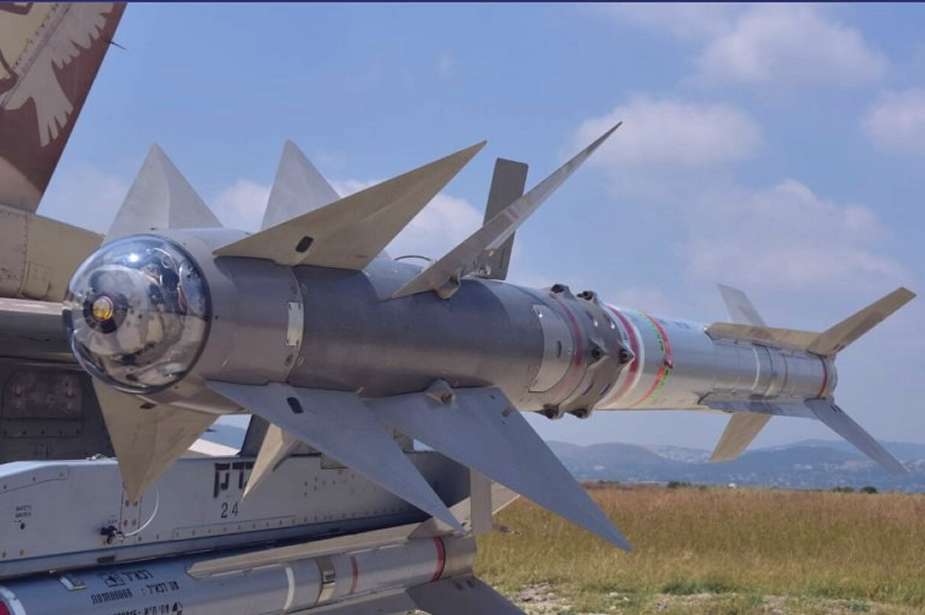Echoed by channelnewsasia.com, the Republic of Singapore Air Force (RSAF) has made a public announcement regarding the enhancement of its F-16C/D+ fighter jets, equipping them with one of the world's most advanced guided missiles. A display panel at the Paya Lebar Air Base, the venue for RSAF's upcoming 55th-anniversary open house on Saturday (Sep 9) and Sunday, proudly showcases the integration of Python-5 missiles into its Lockheed Martin F-16 C/D/D+ fighter aircraft.
Follow Air Recognition on Google News at this link
 The Python-5 is the latest addition to the Python family of Air-to-Air Missiles (AAMs) (Picture source: Rafael)
The Python-5 is the latest addition to the Python family of Air-to-Air Missiles (AAMs) (Picture source: Rafael)
These high-tech short-range air-to-air missiles, produced by the Israeli defense company Rafael Advanced Defense Systems, possess the capability to neutralize aerial threats within a 20-kilometer radius. Additionally, these missiles feature a modern targeting system, enabling pilots to lock onto enemy aircraft and engage them with precision without the need for altering their flight trajectory.
The Python is a family of air-to-air missiles (AAMs) built by the Israeli weapons manufacturer Rafael Advanced Defense Systems, formerly RAFAEL Armament Development Authority. Originally, the Shafrir-1 missile was developed in 1959, followed by the Shafrir-2 in early 1970s. Subsequently, the missiles were given the western name of "Python" by the parent company for export purposes, starting with the Python-3 in 1978. Since then, it has been further developed and evolved into Python-4, Python-5, Derby and also, the Spyder. The Python-5 is the latest addition to the Python family of Air-to-Air Missiles (AAMs). This advanced AAM has garnered significant attention and acclaim for its exceptional capabilities, making it one of the most formidable AAMs globally.
During certification tests conducted by the Indian Air Force, the Python-5 AAM demonstrated its prowess when fired from the HAL Tejas fighter aircraft. This impressive missile has also been integrated into the Indian Air Force's arsenal, showcasing its versatility in combat scenarios.
The Python-5 stands out as a pinnacle of air-to-air missile technology. It currently holds the distinction of being the most potent air-to-air missile within Israel's inventory and is regarded as one of the world's most cutting-edge AAMs. Its exceptional features and performance capabilities have made it a force to be reckoned with in modern aerial warfare.
One of the Python-5's standout features is its beyond-visual-range capability, allowing it to engage targets even when not in direct line of sight. This capability is achieved through the "lock-on after launch" (LOAL) mechanism. Furthermore, the missile boasts full-sphere, all-directional attack capabilities, including the ability to engage targets from behind.
The Python-5's advanced seeker system incorporates electro-optical and imaging infrared homing technology. This sophisticated seeker scans the target area to identify hostile aircraft, locks onto its target for terminal chase, and ensures a high level of accuracy during the engagement. The missile's design is equally impressive, featuring a complex arrangement of eighteen aerodynamic surfaces to enhance its maneuverability and performance.
The Python-5 made its combat debut during the 2006 Lebanon War, where it played a crucial role. F-16 Fighting Falcons equipped with Python-5 missiles successfully destroyed two Iranian-made Ababil UAVs employed by Hezbollah. This marked the beginning of the Python-5's combat legacy.
In a more recent event on May 13, 2021, an Israeli F-16 intercepted and shot down a Hamas-operated Shehab suicide drone using a Python-5 air-to-air missile, reaffirming the missile's effectiveness and reliability in contemporary combat scenarios. Currently, the missiles are in service with the armed forces of over fifteen countries from around the world.
















